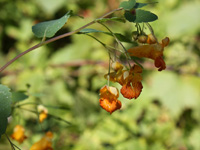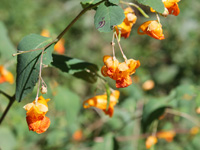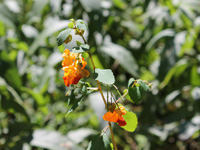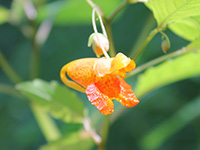![]()
Spotted Jewelweed (Impatiens capensis) is an annual plant native to North America, commonly found thriving in moist, bottomland soils, ditches, and along creeks. It often grows alongside its less common relatives, Yellow Jewelweed (Impatiens pallida) and Pale Spotted Jewelweed (Impatiens ecalcarata), forming dense colonies in wet, shaded environments. This species is well adapted to riparian habitats, where its ability to spread rapidly makes it a dominant feature of the landscape.
Interestingly, the species name capensis, meaning "of the Cape," is actually a misnomer. The Dutch botanist Nicolaas Meerburgh mistakenly believed that Spotted Jewelweed was native to the Cape of Good Hope in southern Africa when, in reality, it originates from North America. Despite this naming error, the plant has successfully expanded beyond its native range. In the 19th and 20th centuries, Impatiens capensis was introduced to several European countries, including England, France, the Netherlands, Poland, Sweden, and Finland, where naturalized populations have persisted even without intentional cultivation. This adaptability has allowed it to establish itself in new environments, particularly in regions with similar wetland conditions.
Spotted Jewelweed bears a close resemblance to Impatiens noli-tangere, a species of Impatiens native to Europe and Asia, as well as to other North American Impatiens species. While their habitats and growth patterns are strikingly similar, there is currently no known evidence of natural hybrids between these species. The ecological niche occupied by Spotted Jewelweed and its relatives highlights the plant’s role in providing important resources for pollinators and wildlife in wetland ecosystems.
![]()
Spotted Jewelweed is commercially harvested as a natural remedy for poison ivy rashes.
![]() Spotted Jewelweed (Impatiens capensis) has long been valued for its medicinal properties, particularly as a natural remedy for poison ivy rashes. This plant has been traditionally used by Indigenous peoples and herbalists to soothe skin irritations caused by exposure to Toxicodendron radicans (poison ivy) and other plants that cause allergic reactions. The juice extracted from the stems and leaves of Spotted Jewelweed contains compounds that are believed to counteract urushiol, the toxic oil responsible for the itching and inflammation associated with poison ivy contact.
Spotted Jewelweed (Impatiens capensis) has long been valued for its medicinal properties, particularly as a natural remedy for poison ivy rashes. This plant has been traditionally used by Indigenous peoples and herbalists to soothe skin irritations caused by exposure to Toxicodendron radicans (poison ivy) and other plants that cause allergic reactions. The juice extracted from the stems and leaves of Spotted Jewelweed contains compounds that are believed to counteract urushiol, the toxic oil responsible for the itching and inflammation associated with poison ivy contact.
When applied to affected areas, Jewelweed’s sap is thought to have anti-inflammatory and soothing properties, helping to reduce redness, swelling, and itching. Some studies suggest that its effectiveness may be due to the presence of lawsone, a natural chemical that may help neutralize urushiol’s effects on the skin. Fresh plant preparations, such as crushed leaves, stem juice, or infusions, are often applied directly to the rash for relief. In addition to its use as a fresh remedy, Jewelweed is sometimes processed into herbal salves, soaps, and tinctures to provide longer-lasting treatments for poison ivy and other skin irritations.
Because of its natural skin-soothing properties, Spotted Jewelweed continues to be a widely recognized and utilized remedy for those seeking alternatives to commercial treatments for poison ivy reactions. Its availability in moist, woodland areas makes it an accessible and practical plant for foragers and herbal medicine practitioners alike.
Please note that MIROFOSS does not suggest in any way that plants should be used in place of proper medical and psychological care. This information is provided here as a reference only.
![]()
The seeds of Spotted Jewelweed (Impatiens capensis) are considered edible and are known for their mild, nutty flavor, often compared to that of walnuts. These seeds are small but can be foraged and eaten raw, making them a unique and interesting wild food source. In addition to the seeds, the young, tender stems of the plant can also be consumed when properly prepared. When cooked, they have a texture similar to green beans and can be incorporated into various dishes. However, caution must be exercised when consuming Spotted Jewelweed, as the plant contains calcium oxalate, a compound that can cause an unpleasant burning sensation in the mouth and throat if ingested in its raw form.
To safely prepare the young shoots for consumption, they should be boiled for 10 to 15 minutes in two changes of water, which helps to break down and remove most of the calcium oxalate content. It is essential to discard the water used for boiling, as it may still contain residual calcium oxalate, which can be harmful if consumed. While Spotted Jewelweed can be a foraged food source when prepared correctly, it is important to recognize the risks associated with improper preparation. As with many wild edible plants, those unfamiliar with its preparation should proceed with care and ensure they are following safe cooking practices before consumption.
Please note that MIROFOSS can not take any responsibility for any adverse effects from the consumption of plant species which are found in the wild. This information is provided here as a reference only.
![]()
Spotted Jewelweed (Impatiens capensis) thrives in wet, low-lying environments, making it a common sight along the banks of rivers, ditches, swamps, and canals, as well as in moist woodlands. This annual plant is highly adaptable and can grow in a variety of soil types, including light sandy, medium loamy, and even heavy clay soils. It is particularly well suited for areas with consistently damp or waterlogged conditions, where few other plants can flourish. Spotted Jewelweed is also tolerant of a wide range of soil pH levels, growing equally well in acidic, neutral, and alkaline soils.
In terms of light requirements, Spotted Jewelweed is flexible, capable of thriving in both semi-shaded areas, such as light woodlands, and in fully exposed, unshaded locations. However, regardless of its light conditions, the plant has a strong preference for moist soil, which is essential for its successful growth and spread. Beyond its ecological role in stabilizing wetland soils and providing nectar for pollinators, Spotted Jewelweed is also known to attract certain bird species. Its vibrant, trumpet-shaped flowers serve as a valuable nectar source, particularly for hummingbirds, which are often seen visiting the plant throughout the growing season. This mutual relationship between Spotted Jewelweed and birds further highlights the plant’s importance in supporting biodiversity in wetland ecosystems.
| Soil Conditions | |
| Soil Moisture | |
| Sunlight | |
| Notes: |
![]()
Spotted Jewelweed (Impatiens capensis) is an annual plant that grows between 60 and 150 centimeters in height, featuring thinly ovate leaves that range from 4 to 9 centimeters in length. The leaves are arranged alternately along the stem and have a distinctive quality—when submerged in water, they appear silver or "jeweled," likely contributing to the plant's common name. This shimmering effect is due to the microscopic air bubbles trapped on the leaf surface, reflecting light in a striking manner.
The flowers of Spotted Jewelweed are vibrant orange and have a unique three-lobed corolla. One of the calyx lobes, which is similarly colored to the corolla, extends into a hooked, conical spur at the back of the flower. In addition to its showy, pollinator-attracting blossoms, Spotted Jewelweed also produces non-showy cleistogamous flowers. These flowers remain closed and self-pollinate without the need for cross-pollination, ensuring the plant can reproduce even in conditions where pollinators are scarce.
A key feature of Spotted Jewelweed’s flowers is their nectar spurs—tubular elongations of the petals and sepals that contain nectar. These spurs play an essential role in plant-pollinator interactions and are believed to be a product of coevolution between the plant and its pollinators. The curvature of the nectar spurs in Spotted Jewelweed is highly variable, ranging from 0 degrees (straight) to 270 degrees (sharply curved). This angle is crucial in determining which pollinators are best suited to accessing the nectar and facilitating effective pollination.
Hummingbirds are the primary pollinators of Spotted Jewelweed and are particularly efficient in pollen transfer. Studies have shown that they remove more pollen per visit from flowers with curved nectar spurs than from those with perpendicular spurs, indicating that spur curvature influences pollination success. However, hummingbirds are not the only pollinators of this plant. Bees, particularly bumblebees, also play a significant role in pollination, ensuring high reproductive success for Spotted Jewelweed. The combined efforts of hummingbirds and bees contribute to the high pollination rate of this species, supporting its widespread presence in moist, shaded environments across its native range.
Other than in the basic natural form, spotted jewelweed can be found in one distinct variety:
![]()
| Plant Height | 60cm to 150cm | 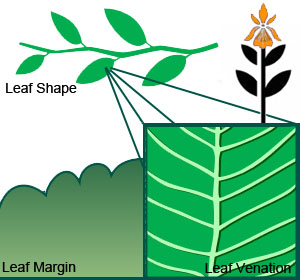 |
| Habitat | Moist Woods, shaded wetlands, shorelines | |
| Leaves | alternate 4cm to 9cm long | |
| Leaf Margin | Crenate | |
| Leaf Venation | Pinnate | |
| Stems | smooth stems | |
| Flowering Season | July to October | |
| Flower Type | Bilaterially Symmetrical | |
| Flower Colour | Orange | |
| Pollination | Bees, hummingbirds | |
| Flower Gender | Flowers are hermaphrodite and the plants are self-fertile | |
| Fruit | small seeds in a swollen capsule | |
| USDA Zone | 4A (-31°C to -34°C) cold weather limit |
![]()
The following health hazards should be noted when handling or choosing a location to plant spotted jewelweed:
 |
POSSIBLE TOXICITY Spotted Jewelweed contains large amounts of calcium oxalate which can cause severe digestive upset, breathing difficulties, convulsions, coma, and possibly death if large enough quantities are consumed. |
![]()
 |
-Click here- or on the thumbnail image to see an artist rendering, from The United States Department of Agriculture, of spotted jewelweed. (This image will open in a new browser tab) |
![]()
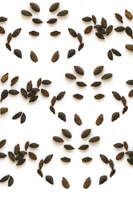 |
-Click here- or on the thumbnail image to see a magnified view, from Prairie Moon Nursery, of the seeds created by spotted jewelweed for propagation. (This image will open in a new browser tab) |
![]()
Spotted Jewelweed can be referenced in certain current and historical texts under the following four names:

![]()
 |
What's this? What can I do with it? |
![]()
| Dickinson, T.; Metsger, D.; Bull, J.; & Dickinson, R. (2004) ROM Field Guide to Wildflowers of Ontario, Royal Ontario Museum, Toronto:McClelland and Stewart Ltd. | |
| Strausbaugh, P.D. & Core, E. L. (1964) Flora of West Virginia. 2nd ed. Seneca Books Inc., ISBN 0-89092-010-9 |
|
| Travers, Steven E; Temeles, Ethan J; Pan, Irvin (2003). "The relationship between nectar spur curvature in jewelweed (Impatiens capensis) and pollen removal by hummingbird pollinators". Canadian Journal of Botany | |
| MacKinnon, Kershaw, Arnason, Owen, Karst, Hamersley, Chambers. 2009. Edible & Medicinal Plants Of Canada ISBN 978-1-55105-572-5 |
|
| USDA-NRCS PLANTS Database / USDA NRCS. Wetland flora: Field office illustrated guide to plant species. USDA Natural Resources Conservation Service. | |
| National Audubon Society. Field Guide To Wildflowers (Eastern Region): Alfred A. Knopf. ISBN 0-375-40232-2 | |
| February 23, 2025 | The last time this page was updated |
| ©2025 MIROFOSS™ Foundation | |
 |
|

